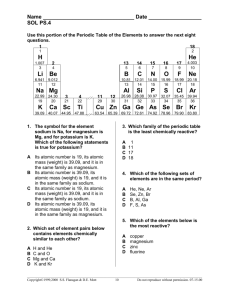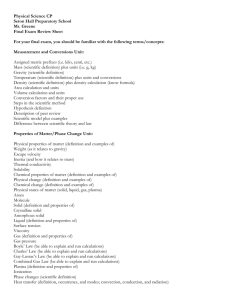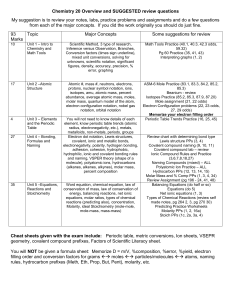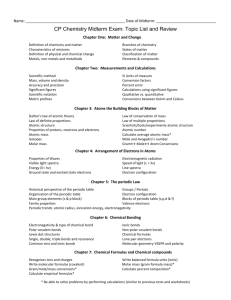Physical Science study guide for midterm 2014 This is an outline of
advertisement
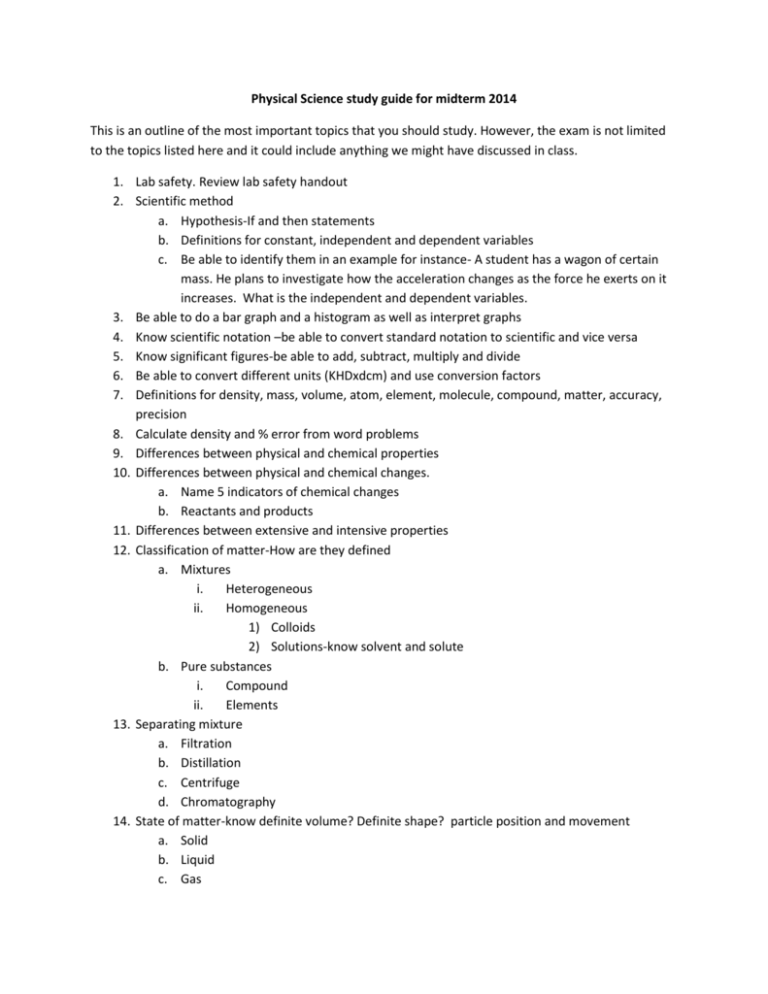
Physical Science study guide for midterm 2014
This is an outline of the most important topics that you should study. However, the exam is not limited
to the topics listed here and it could include anything we might have discussed in class.
1. Lab safety. Review lab safety handout
2. Scientific method
a. Hypothesis-If and then statements
b. Definitions for constant, independent and dependent variables
c. Be able to identify them in an example for instance- A student has a wagon of certain
mass. He plans to investigate how the acceleration changes as the force he exerts on it
increases. What is the independent and dependent variables.
3. Be able to do a bar graph and a histogram as well as interpret graphs
4. Know scientific notation –be able to convert standard notation to scientific and vice versa
5. Know significant figures-be able to add, subtract, multiply and divide
6. Be able to convert different units (KHDxdcm) and use conversion factors
7. Definitions for density, mass, volume, atom, element, molecule, compound, matter, accuracy,
precision
8. Calculate density and % error from word problems
9. Differences between physical and chemical properties
10. Differences between physical and chemical changes.
a. Name 5 indicators of chemical changes
b. Reactants and products
11. Differences between extensive and intensive properties
12. Classification of matter-How are they defined
a. Mixtures
i.
Heterogeneous
ii.
Homogeneous
1) Colloids
2) Solutions-know solvent and solute
b. Pure substances
i.
Compound
ii.
Elements
13. Separating mixture
a. Filtration
b. Distillation
c. Centrifuge
d. Chromatography
14. State of matter-know definite volume? Definite shape? particle position and movement
a. Solid
b. Liquid
c. Gas
15. Phase changes- freezing, melting, condensation, evaporation, sublimation
16. Endothermic and exothermic reactions
17. Periodic table
a. Properties of metal, non-metals and metalloids
b. Periods, family and groups
c. Noble gases location
18. Law of conservation of mass (no calculations)
19. Law of definite proportions (no calculations)
20. Law of multiple proportions (no calculations)
21. 5 main points in Dalton’s theory, which are not correct
22. Atom and its sub-particles ( Neutrons, Protons, Electrons, relative charges, mass. Be able to
determine the number of dub-atomic particles)
23. Thomson’s significance (what did he discovered and how, theory/model)
24. Rutherford significance (what did he discover and how, theory/model)
25. Modern atomic theory
26. Relative atomic mass and atomic mass unit
27. Average atomic mass (no calculations)
28. Atomic number
29. Isotopes
30. ions
31. Mass number
32. Mole
33. Avogrado’s number
34. Molar mass- be able to do problems with molar mass conversions
35. Electron dot diagram36. Chemical bond
37. Ionic Bond38. Covalent bonds39. Non-polar covalent bonds 40. Polar covalent bonds41. Molecule42. Molecular compound43. Chemical formula 44. Diatomic molecule
45. Valence electrons46. Octet rule
47. Anion
48. Cation
49. Polyatomic ions
50. Metallic bonds
51. How are different bonds formed? (ionic, covalent, metallic)
52. be able to predict what type of bond will form based on what elements are involved
53. Characteristics of bonds ( types of bonds, melting points, boiling points, electrical conductivity,
solubility for ionic, covalent {non-polar, polar} and metallic )
54. Need to know how to name ionic compounds and covalent compounds ( you should be able to
recognize what type of bond you have based on what atoms are present )
55. Know prefixes for naming covalent compounds
56. Chemical formulas. You should be able to write a chemical formula from a chemical name
57. Chemical reactions (reactant, products )
58. Balancing equations
59. Types of reactions (synthesis, decomposition, single and double displacement and combustions)
you should be able to identify a reaction by looking at the chemical equation
60. Know the general form for each reaction




